
It looks like 2023 could shape up to be the year that we reach “peak 5G.” While T-Mobile still enjoys a very healthy lead over its rivals, we’re no longer seeing significant speed increases from any of the big three U.S. carriers.
That’s not surprising for T-Mobile and Verizon since they now cover more than two-thirds of the U.S. population. AT&T still has room to grow, yet it seems to be in a resting phase rather than an expansion one right now.
Today, Ookla released its second-quarter 2023 market report, and the latest numbers are surprising — not in terms of the speeds we’re seeing from carriers, but because of how little has changed since its last report in April. There’s been some slight shifting within individual regions and cities, but overall median speeds remain the same, as does the lineup of the fastest 5G smartphones.
T-Mobile remains unchallenged

At this point, it shouldn’t come as a shock that T-Mobile is still delivering the fastest 5G speeds across the country. The “Un-carrier” has enjoyed a huge advantage thanks to having a swath of faster midrange spectrum that it could deploy two years before its rivals, and it hasn’t sat still.
What’s more surprising is that Verizon and AT&T don’t appear to be closing that gap. Although the two carriers didn’t get clearance to roll out their faster C-band spectrum until early 2022, it hasn’t become the game-changer that many expected. While Verizon has aggressively rolled out its new C-band far and wide as part of its 5G Ultra Wideband network, which now covers over 200 million people, it still trails far behind T-Mobile in performance. Meanwhile, AT&T doesn’t even seem to be trying, with its midrange 5G Plus network only available in a handful of cities.
According to Ookla’s latest market analysis, T-Mobile provides median download speeds of 164.76Mbps across both 4G/LTE and 5G services. That’s more than double Verizon’s score of 72.61Mbps, and 2.5 times faster than AT&T’s 66.16Mbps.

Things get a bit closer when we zero in on 5G performance, where T-Mobile clocks in at 220Mbps compared to Verizon’s 133.5Mbps, but AT&T still lags behind at 86.01Mpbs — likely due to its much smaller midrange 5G footprint compared to its slower nationwide low-band 5G coverage.
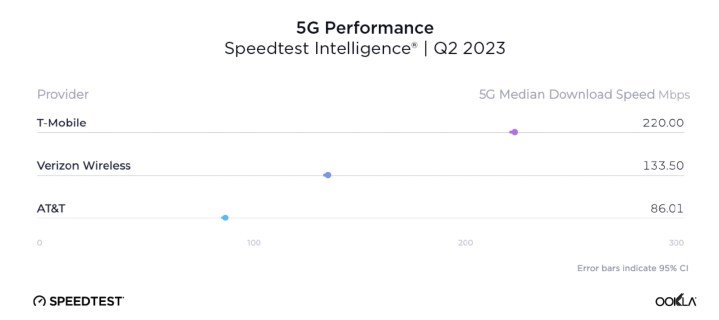
Technically, most of the numbers show a slight decrease over the last report, where T-Mobile came in at 165.22Mbps overall and 220.70Mbps in 5G speeds. Verizon improved in 5G speeds from its 132.72Mbps April score to 133.5Mbps in the latest report, but it also dropped in overall speeds from 75.40Mbps to 72.61Mbps. However, since these figures have a 95% confidence interval, those changes are statistically insignificant — they effectively show there’s been no change at all in the median download speeds across all three carriers since the last report.
Scores remained unchanged in most other areas as well, with T-Mobile delivering slightly higher consistency (86.1%) than Verizon (81.5%) and AT&T (79.2%). This measures the percentage of time that customers on each provider could get at least a 5Mbps download and 1Mpbs upload speed. The scores for 5G consistency, which pushes those thresholds to 25Mpbs and 3Mpbs, were a bit closer, with T-Mobile coming in at 75.9%, Verizon at 75.1%, and AT&T lagging behind at 66.4%.
The numbers by state
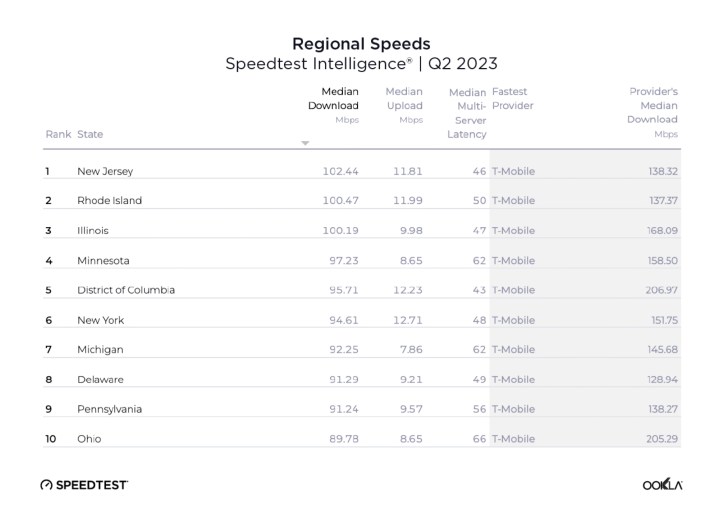
The lineup of the 10 fastest U.S. states has shuffled a bit since the last report, with New Jersey now taking the top spot, trading its former fourth-place position with Minnesota. Rhode Island and Illinois remain in second and third, respectively, while the District of Columbia took back the fifth spot, once again pulling ahead of New York. Massachusetts dropped to 11th place, putting Ohio back on the top 10 list.
Nevertheless, median speeds in all those states appear to have plummeted since April. New Jersey comes in with a score of 102.44Mbps, which is actually slower than its April fourth-place speed of 106.12Mbps. Minnesota, which took first place in April with median speeds of 111.67Mbps, dropped below the 100Mbps mark at 97.23Mbps, moving to fourth place. The same thing happened to New York, which went from 101.18Mbps in April down to 94.61Mbps in the most recent report. This is the first time in quite a while that we’ve seen this kind of a drop in speeds at the regional level.
Not surprisingly, T-Mobile was the fastest mobile provider in the vast majority of states and the District of Columbia. It now leads in only 44 states after losing its lead in North Dakota and South Dakota, which were declared too close to call this time around, along with Vermont and West Virginia. AT&T retook its lead in the previously tied Montana, while regional carrier GCI remained the top carrier in Alaska.
At the bottom of the list, Mississippi moved out of last place and up to 49th (out of 51), but that likely had more to do with Wyoming and Alaska slowing down than Mississippi’s slight improvement from 36.65Mbps to 37.36Mbps. Speeds in Wyoming dropped slightly to 35.18Mbps, falling below even Mississippi’s old score, and Alaska did very poorly this time with median speeds of only 31Mbps.
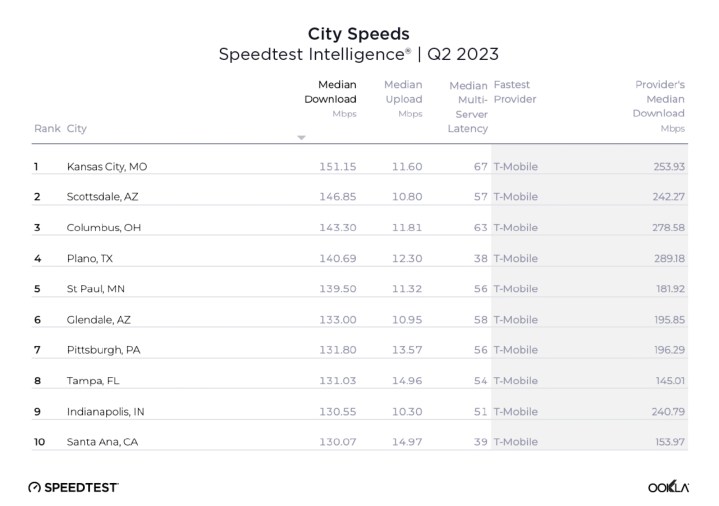
The top five cities in this month’s report are Kansas City, Missouri; Scottsdale, Arizona; Columbus, Ohio; Plano, Texas; and St. Paul, Minneapolis. Glendale, Arizona, which was No. 1 last time around, plummeted from its 176.79Mbps speeds down to 133Mbps, falling into sixth place.
St. Paul also saw a drop from its former second-place score of 154.62Mbps down to 139.5Mbps, putting it in fifth place, while Kansas City and Scottsdale jumped from 140.62Mbps to 151.15Mbps and 139.05Mbps to 146.85Mbps, respectively, to land in the top two spots. Columbus also made it back into the top five, landing in third place with a score of 143.3Mbps, a slight increase over its April 137.48Mbps speeds that had left it in sixth place.
The fastest smartphones for 5G
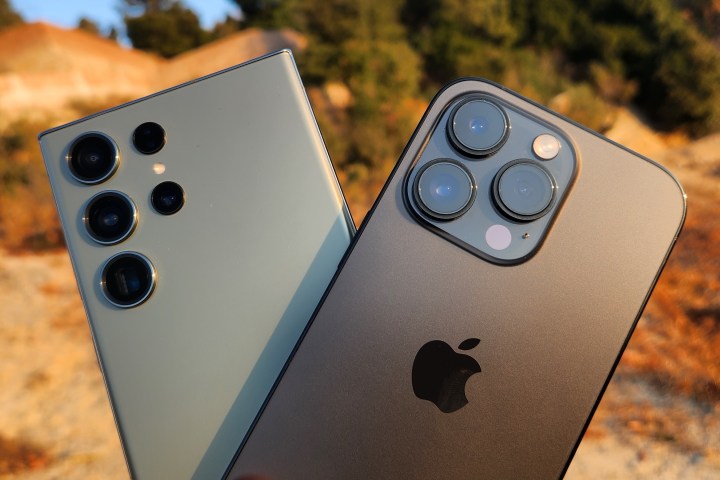
As usual, Ookla also rounded up the top five smartphones and chipsets, although not much has changed here since April. Unsurprisingly, Samsung’s Galaxy S23 Ultra still comes out on top, followed by the Galaxy Z Fold 4, Google Pixel 7 Pro, iPhone 14 Pro Max, and Galaxy S22 Ultra.
That’s the same ranking as we saw in April, although the figures have changed slightly. The S23 Ultra dropped in median speeds from 161.86Mbps in April down to 146.79Mbps, but that was still enough to eclipse the Z Fold 4. The other three smartphones saw similar drops of 2 to 3 Mbps in measured speeds.
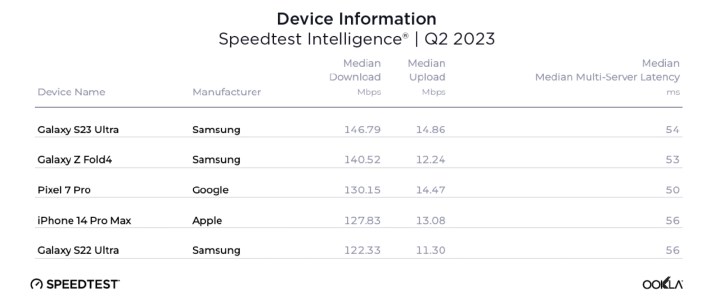
Those results were consistent when comparing manufacturers, with Samsung posting a median download speed across all its devices of 90.83Mbps, while Apple came in second at 75.65Mbps. Again, these numbers dropped slightly, but not significantly, from April’s report. For chipsets, Qualcomm’s Snapdragon 8 Gen 2 came out on top, followed by the Snapdragon 8+ Gen 1, Google’s Tensor G2, the Snapdragon X65 5G modem used in Apple’s iPhone 14 lineup, and finally, the Snapdragon 8 Gen 1. Interestingly, although the ranking of these chipsets corresponds directly to the ranking of the top five smartphones that use them, those chips are found in many other devices as well.
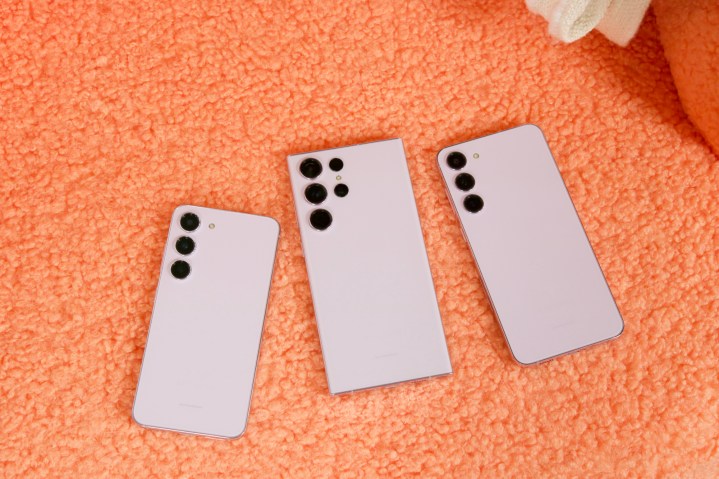
There’s also an important caveat when it comes to these smartphone scores. Ookla’s methodology relies on samples recorded by customers using its popular Speedtest apps, so the numbers can be influenced by device popularity and customer expectations. For example, since the entire iPhone 14 lineup uses Qualcomm’s Snapdragon X65 5G modem, there’s no reason why an iPhone 14 Pro Max should offer significantly faster download speeds than an iPhone 14 Pro or even the standard iPhone 14. Ditto for the Samsung Galaxy S23 lineup, all of which are powered by the same bespoke Qualcomm Snapdragon 8 Gen 2 chip, and the Pixel 7, which uses the same Google Tensor G2 chip as its larger sibling.
The higher scores for the iPhone 14 Pro Max, Galaxy S23 Ultra, and Pixel 7 Pro almost certainly stem from the fact that these are each company’s most expensive flagship devices, and customers who are buying the biggest and the best are more likely to run speed tests to find out how well their expensive new smartphones are actually performing. However, as Ookla’s chipset rankings show, you don’t need to opt for the “Ultra” or “Max” versions to get the best download speeds.
Editors' Recommendations
- Visible’s affordable 5G plans just got even cheaper
- Visible just made its unlimited 5G plan better than ever
- Have T-Mobile? Your 5G service is about to get much faster
- This tiny dongle will change 5G connectivity forever
- Everything you need to know about the massive AT&T outage




